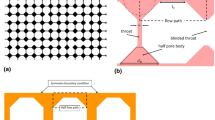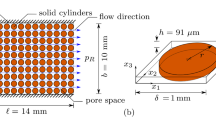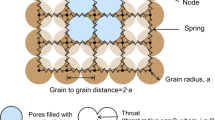Abstract
Pore network modeling (PNM) allows for a major reduction in computational cost when performing pore-scale flow simulations in porous media. Despite the increasing use of such a modeling approach, the studies tackling the simulation of the flow of non-Newtonian fluids are scarce and lack experimental validation. This represents a stumbling block due to nascent state of this field. Moreover, the choice of pore and throat shapes is often arbitrary and its effects on the accuracy of the numerical simulations have not been systematically evaluated. Previous research showed that shear-thinning fluids are deeply sensitive to the morphology of flow channels. The present work deals with the modeling of the flow of Newtonian and shear-thinning fluids through packs of spherical beads, with the aim to develop a reliable procedure to predict such flows based on PNM. A set of PNM flow simulations were performed using different pore morphologies, and the results were compared to previous experimental data. The effects of the rheological parameters and the size of the spheres were extensively evaluated. In this manner, the most suitable shape and geometry was identified and the differences between the results for Newtonian and non-Newtonian fluids analyzed. Furthermore, the permeability value computed by PNM and direct numerical simulations was compared to ensure the representativeness of the extracted networks. The results showed that PNM provides accurate predictions of the flow of both Newtonian and shear-thinning fluids provided that the appropriate pore shape is used.
Article Highlights
-
The flow of Carreau fluids in porous media is predicted using pore network modeling
-
Suitable morphologies and dimensions of the model pore geometries are identified.
-
The proposed model is validated by comparing the predictions to experimental data.







Similar content being viewed by others
Change history
05 July 2023
The first and last name of author "Antonio Rodríguez de Castro" is corrected.
References
Aghabozorgi, S., Rostami, B.: An investigation of polymer adsorption in porous media using pore network modelling. Transp. Porous Media 115, 169–187 (2016). https://doi.org/10.1007/s11242-016-0760-5
Agnaou, M., Sadeghi, M.A., Tranter, T.G., Gostick, J.T.: Modeling transport of charged species in pore networks: solution of the Nernst-Planck equations coupled with fluid flow and charge conservation equations. Comput. Geosci. 140, 104505 (2020)
Akbari, M., Sinton, D., Bahrami, M.: Viscous flow in variable cross-section microchannels of arbitrary shapes. Int. J. Heat Mass Transf. 54, 3970–3978 (2011)
Ali, D., Sen, S.: Permeability and fluid flow-induced wall shear stress of bone tissue scaffolds: computational fluid dynamic analysis using Newtonian and non-Newtonian blood flow models. Comput. Biol. Med. 99, 201–208 (2018). https://doi.org/10.1016/j.compbiomed.2018.06.017
Aliabadian, E., Esmaeili, S., Sadeghi, S., Maini, B., Sundararaj, U., Chen, Z.: New insight to polymer transport in porous media to enhance heavy oil recovery: lab experiment and numerical simulation. Fuel 322, 124257 (2022). https://doi.org/10.1016/j.fuel.2022.124257
Amani, A., Balcázar, N., Naseri, A., Rigola, J.: A numerical approach for non-Newtonian two-phase flows using a conservative level-set method. Chem. Eng. J. 385, 123896 (2020). https://doi.org/10.1016/j.cej.2019.123896
Airiau, C., Bottaro, A.: Flow of shear-thinning fluids through porous media. Adv. Water Resour. 143, 103658 (2020)
Balhoff, M., Sanchez-Rivera, D., Kwok, A., Mehmani, Y., Prodanović, M.: Numerical algorithms for network modeling of yield stress and other non-Newtonian fluids in porous media. Transp. Porous Media. 93, 363–379 (2012). https://doi.org/10.1007/s11242-012-9956-5
Balhoff, M.T., Thompson, K.E.: A macroscopic model for shear-thinning flow in packed beds based on network modeling. Chem. Eng. Sci. 61, 698–719 (2006). https://doi.org/10.1016/j.ces.2005.04.030
Barnoon, P., Toghraie, D.: Numerical investigation of laminar flow and heat transfer of non-Newtonian nanofluid within a porous medium. Powder Technol. 325, 411–429 (2018). https://doi.org/10.1016/j.powtec.2017.10.040
Bird, R.B.: Useful non-Newtonian models. Annu. Rev. Fluid Mech. 8, 13–34 (1976). https://doi.org/10.1146/annurev.fl.08.010176.000305
Blunt, M.J., Jackson, M.D., Piri, M., Valvatne, P.H.: Detailed physics, predictive capabilities and macroscopic consequences for pore-network models of multiphase flow. Adv. Water Resour. 25, 1069–1089 (2002). https://doi.org/10.1016/S0309-1708(02)00049-0
Carreau, P.J.: Rheological equations from molecular network theories. Trans. Soc. Rheol. 16, 99–127 (1972)
Chauveteau, G.: Rodlike polymer solution flow through fine pores: influence of pore size on rheological behavior. J. Rheol. 26, 111–142 (1982)
Chauveteau, G., Zaitoun, A.: Basic rheological behavior of xanthan polysaccharide solutions in porous media: effects of pore size and polymer concentration. In: Proceedings of the first European symposium on enhanced oil recovery, Bournemouth, England, Society of Petroleum Engineers, Richardson, TX. pp. 197–212 (1981)
Cristo, C.D., Iervolino, M., Moramarco, T., Vacca, A.: Applicability of Kinematic model for mud-flows: an unsteady analysis. J. Hydrol. 577, 123967 (2019). https://doi.org/10.1016/j.jhydrol.2019.123967
De, S., Kuipers, J.A.M., Peters, E.A.J.F., Padding, J.T.: Viscoelastic flow simulations in random porous media. J. Nonnewton. Fluid Mech. 248, 50–61 (2017a)
De, S., Kuipers, J. A. M., Peters, E. A. J. F., Padding, J. T.: Viscoelastic flow past mono-and bidisperse random arrays of cylinders: flow resistance, topology and normal stress distribution. Soft Matter. 48 (2017b)
Druetta, P., Picchioni, F.: Influence of physical and rheological properties of sweeping fluids on the residual oil saturation at the micro- and macroscale. J. Non-Newton. Fluid Mech. 286, 104444 (2020). https://doi.org/10.1016/j.jnnfm.2020.104444
Finney, J.: Random packings and the structure of simple liquids. I. The geometry of random close packing. Proc. R. Soc. Lond. Math. Phys. Sci. 319, 479–493 (1970)
Finney, J., Prodanovic, M.: Finney packing of spheres. Digit. Rocks Portal Httpwww Digit. Orgprojects471017612P78G69 (2016)
Forey, N., Atteia, O., Omari, A., Bertin, H.: Saponin foam for soil remediation: on the use of polymer or solid particles to enhance foam resistance against oil. J. Contam. Hydrol. 228, 103560 (2020). https://doi.org/10.1016/j.jconhyd.2019.103560
Forey, N., Atteia, O., Omari, A., Bertin, H.: Use of saponin foam reinforced with colloidal particles as an application to soil remediation: experiments in a 2D tank. J. Contam. Hydrol. (2021). https://doi.org/10.1016/j.jconhyd.2020.103761
Gioia, F., Urciuolo, M.: The containment of oil spills in unconsolidated granular porous media using xanthan/Cr(III) and xanthan/Al(III) gels. J. Hazard. Mater. 116, 83–93 (2004). https://doi.org/10.1016/j.jhazmat.2004.07.008
Gostick, J., Aghighi, M., Hinebaugh, J., Tranter, T., Hoeh, M.A., Day, H., Spellacy, B., Sharqawy, M.H., Bazylak, A., Burns, A., Lehnert, W., Putz, A.: OpenPNM: a pore network modeling package. Comput. Sci. Eng. 18, 60–74 (2016)
Gostick, J.T.: Versatile and efficient pore network extraction method using marker-based watershed segmentation. Phys. Rev. E 96, 023307 (2017). https://doi.org/10.1103/PhysRevE.96.023307
Gostick, J.T., Khan, Z.A., Tranter, T.G., Kok, M.D.R., Agnaou, M., Sadeghi, M., Jervis, R.: PoreSpy: a Python toolkit for quantitative analysis of porous media images. J. Open Source Softw. 4, 1296 (2019). https://doi.org/10.21105/joss.01296
Hauswirth, S.C., Bowers, C.A., Fowler, C.P., Schultz, P.B., Hauswirth, A.D., Weigand, T., Miller, C.T.: Modeling cross model non-Newtonian fluid flow in porous media. J. Contam. Hydrol. 235, 103708 (2020)
Joekar-Niasar, V., Prodanović, M., Wildenschild, D., Hassanizadeh, S.M.: Network model investigation of interfacial area, capillary pressure and saturation relationships in granular porous media. Water Resour. Res. (2010). https://doi.org/10.1029/2009WR008585
Jones, E., Oliphant, T., Peterson, P., others: SciPy: Open source scientific tools for Python (2001)
Kozeny, J.: Uber kapillare leitung der wasser in boden. R. Acad. Sci. Vienna Proc Cl. I(136), 271–306 (1927)
Konangi, S., Palakurthi, N.K., Karadimitriou, N.K., Comer, K., Ghia, U.: Comparison of pore-scale capillary pressure to macroscale capillary pressure using direct numerical simulations of drainage under dynamic and quasi-static conditions. Adv. Water Resour. 147, 103792 (2021). https://doi.org/10.1016/j.advwatres.2020.103792
Kumar, M., Guasto, J.S., Ardekani, A.M.: Transport of complex and active fluids in porous media. J. Rheol. 66, 375 (2022). https://doi.org/10.1122/8.0000389
Lamont, K., Pensini, E., Marangoni, A.G.: Gelation on demand using switchable double emulsions: a potential strategy for the in situ immobilization of organic contaminants. J. Colloid Interface Sci. 562, 470–482 (2020). https://doi.org/10.1016/j.jcis.2019.11.090
Lanza, F., Rosso, A., Talon, L., Hansen, A.: Non-Newtonian rheology in a capillary tube with varying radius. Transp. Porous Media 145, 245–269 (2022). https://doi.org/10.1007/s11242-022-01848-7
Lei, W., Li, Q., Yang, H.-E., Wu, T.-J., Wei, J., Wang, M.: Preferential flow control in heterogeneous porous media by concentration-manipulated rheology of microgel particle suspension. J. Pet. Sci. Eng. (2022). https://doi.org/10.1016/j.petrol.2022.110275
Lei, W., Lu, X., Wang, M.: Multiphase displacement manipulated by micro/nanoparticle suspensions in porous media via microfluidic experiments: from interface science to multiphase flow patterns. Adv. Colloid Interface Sci. 311, 102826 (2023). https://doi.org/10.1016/j.cis.2022.102826
Liu, T.-J., Lin, H.-M., Hong, C.-N.: Comparison of two numerical methods for the solution of non-Newtonian flow in ducts. Int. J. Numer. Methods Fluids 8, 845–861 (1988). https://doi.org/10.1002/fld.1650080707
Lopez, X., Valvatne, P.H., Blunt, M.J.: Predictive network modeling of single-phase non-Newtonian flow in porous media. J. Colloid Interface Sci. 264, 256–265 (2003). https://doi.org/10.1016/S0021-9797(03)00310-2
Marn, J., Delic, M., Zunic, Z.: Non-Newtonian fluid flow analysis with finite difference and finite volume numerical models. Appl. Rheol. 11(6), 325–335 (2001). https://doi.org/10.1515/arh-2001-0019
Martel, R., Hébert, A., Lefebvre, R., Gélinas, P., Gabriel, U.: Displacement and sweep efficiencies in a DNAPL recovery test using micellar and polymer solutions injected in a five-spot pattern. J. Contam. Hydrol. 75, 1–29 (2004). https://doi.org/10.1016/j.jconhyd.2004.03.007
Mcclure, J.: Fluid Configurations in a Random Sphere Packing. Digital Rocks Portal (2016)
Mehmani, Y., Tchelepi, H.A.: Minimum requirements for predictive pore-network modeling of solute transport in micromodels. Adv. Water Resour. (2017). https://doi.org/10.1016/j.advwatres.2017.07.014
Mitra, S., El-Mansori, M., Rodríguez de Castro, A., Costin, M.: Study of the evolution of transport properties induced by additive processing sand mold using X-ray computed tomography. J. Mater. Process. Technol. 277, 116495 (2020)
Morais, A.F., Seybold, H., Herrmann, H.J., Andrade, J.S.: Non-Newtonian fluid flow through three-dimensional disordered porous media. Phys. Rev. Lett. 103, 194502 (2009)
Nilsson, M.A., Kulkarni, R., Gerberich, L., Hammond, R., Singh, R., Baumhoff, E., Rothstein, J.-P.: Effect of fluid rheology on enhanced oil recovery in a microfluidic sandstone device. J Nonnewton Fluid Mech. 202, 112–119 (2013). https://doi.org/10.1016/j.jnnfm.2013.09.011
Nishad, S., Al-Raoush, R.: I: Colloid retention and mobilization mechanisms under different physicochemical conditions in porous media: a micromodel study. Powder Technol. 377, 163–173 (2021). https://doi.org/10.1016/j.powtec.2020.08.086
Omirbekov, S., Davarzani, H., Colombano, S., Ahmadi-Sénichault, A.: Experimental and numerical upscaling of foam flow in highly permeable porous media. Adv. Water Res. (2020). https://doi.org/10.1016/j.advwatres.2020.103761
Pearson, J.R.A., Tardy, P.M.J.: Models for flow of non-Newtonian and complex fluids through porous media. J. Non-Newton. Fluid Mech. 102, 447–473 (2002). https://doi.org/10.1016/S0377-0257(01)00191-4
Perrin, C.L., Tardy, P.M.J., Sorbie, K.S., Crawshaw, J.C.: Experimental and modeling study of Newtonian and non-Newtonian fluid flow in pore network micromodels. J. Colloid Interface Sci. 295, 542–550 (2006). https://doi.org/10.1016/j.jcis.2005.09.012
Rabbani, H.S., Joekar-Niasar, V., Pak, T., Shokri, N.: New insights on the complex dynamics of two-phase flow in porous media under intermediate-wet conditions. Sci. Rep. 7, 4584 (2017). https://doi.org/10.1038/s41598-017-04545-4
Rodríguez de Castro, A., Agnaou, M.: Numerical investigation of the apparent viscosity dependence on darcy velocity during the flow of shear-thinning fluids in porous media. Transp. Porous Media 129, 93–120 (2019). https://doi.org/10.1007/s11242-019-01279-x
Rodríguez de Castro, A., Goyeau, B.: A pore network modelling approach to investigate the interplay between local and Darcy viscosities during the flow of shear-thinning fluids in porous media. J. Colloid Interface Sci. 590, 446–457 (2021)
Rodríguez de Castro, A., Goyeau, B.: Numerical analysis of the pore-scale mechanisms controlling the efficiency of immiscible displacement of a pollutant phase by a shear-thinning fluid. Chem. Eng. Sci. 251, 117462 (2022). https://doi.org/10.1016/j.ces.2022.117462
Rodríguez de Castro, A., Oostrom, M., Shokri, N.: Effects of shear-thinning fluids on residual oil formation in microfluidic pore networks. J. Colloid Interface Sci. 472, 34–43 (2016). https://doi.org/10.1016/j.jcis.2016.03.027
Rodríguez de Castro, A., Radilla, G.: Non-Darcian flow of shear-thinning fluids through packed beads: experiments and predictions using Forchheimer’s law and Ergun’s equation. Adv. Water Resour. 100, 35–47 (2017). https://doi.org/10.1016/j.advwatres.2016.12.009
Rodríguez de Castro, A., Radilla, G.: Flow of yield stress and Carreau fluids through rough-walled rock fractures: prediction and experiments. Water Resour. Res. 53, 6197–6217 (2017). https://doi.org/10.1002/2017WR020520
Savins, J.G.: Non-Newtonian flow through porous media. Ind. Eng. Chem. 61, 18–47 (1969). https://doi.org/10.1021/ie50718a005
Shao, L., Lin, P., Zhu, J., Zhou, Y., Xie, C.: Assessing the apparent viscosity of decane-water emulsion in underground porous media based on the lattice Boltzmann method. Front. Earth Sci. (2023). https://doi.org/10.3389/feart.2022.1055743
Sheng, J.J.: Modern chemical enhanced oil recovery: theory and practice. Gulf Professional Publishing (2010)
Shi, Y., Tang, G.H.: Non-Newtonian rheology property for two-phase flow on fingering phenomenon in porous media using the lattice Boltzmann method. J. Non-Newton. Fluid Mech. 229, 86–95 (2016). https://doi.org/10.1016/j.jnnfm.2015.12.002
Silva, J.A.K., Smith, M.M., Munakata-Marr, J., McCray, J.E.: The effect of system variables on in situ sweep-efficiency improvements via viscosity modification. J. Contam. Hydrol. 136–137, 117–130 (2012). https://doi.org/10.1016/j.jconhyd.2012.05.006
Sochi, T.: Modelling the flow of yield-stress fluids in porous media. Transp. Porous Media 85, 489–503 (2010). https://doi.org/10.1007/s11242-010-9574-z
Sochi, T., Blunt, M.J.: Pore-scale network modeling of Ellis and Herschel-Bulkley fluids. J. Pet. Sci. Eng. 60, 105–124 (2008). https://doi.org/10.1016/j.petrol.2007.05.009
Sorbie, K.S., Clifford, P.J.: The inclusion of molecular diffusion effects in the network modelling of hydrodynamic dispersion in porous media. Chem. Eng. Sci. 46, 2525–2542 (1991). https://doi.org/10.1016/0009-2509(91)80046-2
Sorbie, K.S., Clifford, P.J., Jones, E.R.W.: The rheology of pseudoplastic fluids in porous media using network modeling. J. Colloid Interface Sci. 130, 508–534 (1989). https://doi.org/10.1016/0021-9797(89)90128-8
Tsakiroglou, C.D.: A methodology for the derivation of non-Darcian models for the flow of generalized Newtonian fluids in porous media. J. Non-Newton. Fluid Mech. 105, 79–110 (2002). https://doi.org/10.1016/S0377-0257(02)00066-6
Tsakiroglou, C.D.: Correlation of the two-phase flow coefficients of porous media with the rheology of shear-thinning fluids. J. Non-Newton. Fluid Mech. 117, 1–23 (2004). https://doi.org/10.1016/j.jnnfm.2003.11.005
Tsakiroglou, C.D., Theodoropoulou, M., Karoutsos, V., Papanicolaou, D., Sygouni, V.: Experimental study of the immiscible displacement of shear-thinning fluids in pore networks. J. Colloid Interface Sci. 267, 217–232 (2003). https://doi.org/10.1016/S0021-9797(03)00635-0
Tsakiroglou, C.D., Theodoropoulou, M.A., Karoutsos, V., Papanicolaou, D.: Determination of the effective transport coefficients of pore networks from transient immiscible and miscible displacement experiments. Water Resour. Res. 41, W02014 (2005). https://doi.org/10.1029/2003WR002987
Wang, M., Xiong, Y., Liu, L., Peng, G., Zhang, Z.: Lattice Boltzmann simulation of immiscible displacement in porous media: viscous fingering in a shear-thinning fluid. Transp. Porous Media 126, 411–429 (2019). https://doi.org/10.1007/s11242-018-1162-7
Xie, Ch., Lv, W., Wang, M.: Shear-thinning or shear-thickening fluid for better EOR?—a direct pore-scale study. J. Pet. Sci. Eng. 161, 683–691 (2018). https://doi.org/10.1016/j.petrol.2017.11.049
Xiong, Q., Baychev, T.G., Jivkov, A.P.: Review of pore network modelling of porous media: experimental characterisations, network constructions and applications to reactive transport. J. Contam. Hydrol. 192, 101–117 (2016). https://doi.org/10.1016/j.jconhyd.2016.07.002
Yazdani, A., Li, X., Karniadakis, G.E.: Dynamic and rheological properties of soft biological cell suspensions. Rheol. Acta. 55, 433–449 (2016). https://doi.org/10.1007/s00397-015-0869-4
Yu, W., Kanj, M.Y.: Review of foam stability in porous media: The effect of coarsening. J. Pet. Sci. Eng. 208, 109698 (2022). https://doi.org/10.1016/j.petrol.2021.109698
Zami-Pierre, F., de Loubens, R., Quintard, M., Davit, Y.: Effect of disorder in the pore-scale structure on the flow of shear-thinning fluids through porous media. J. Non-Newton. Fluid Mech. 261, 99–110 (2018). https://doi.org/10.1016/j.jnnfm.2018.08.004
Funding
This research was supported by CANARIE Canada (RS3-141).
Author information
Authors and Affiliations
Corresponding author
Ethics declarations
Conflict of interest
The authors have no relevant financial or non-financial interests to disclose.
Additional information
Publisher's Note
Springer Nature remains neutral with regard to jurisdictional claims in published maps and institutional affiliations.
Supplementary Information
Below is the link to the electronic supplementary material.
Rights and permissions
Springer Nature or its licensor (e.g. a society or other partner) holds exclusive rights to this article under a publishing agreement with the author(s) or other rightsholder(s); author self-archiving of the accepted manuscript version of this article is solely governed by the terms of such publishing agreement and applicable law.
About this article
Cite this article
Rodríguez de Castro, A., Agnaou, M. & Gostick, J. Predicting Shear-Thinning Fluid Flows in Porous Media Using Pore Network Modeling: Simulations and Experimental Validation. Transp Porous Med 149, 453–478 (2023). https://doi.org/10.1007/s11242-023-01968-8
Received:
Accepted:
Published:
Issue Date:
DOI: https://doi.org/10.1007/s11242-023-01968-8




